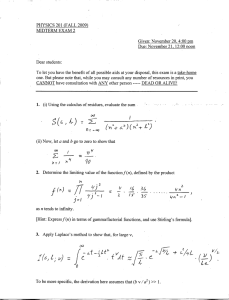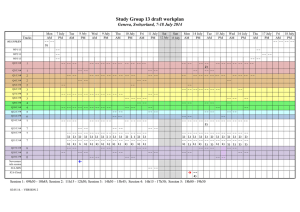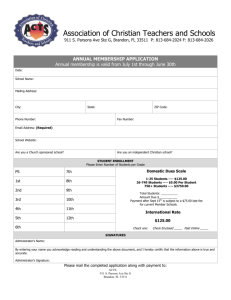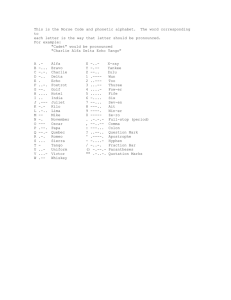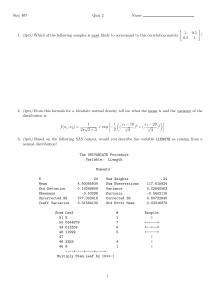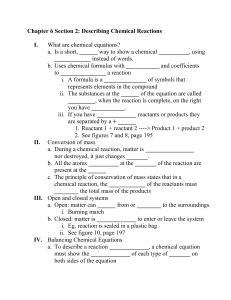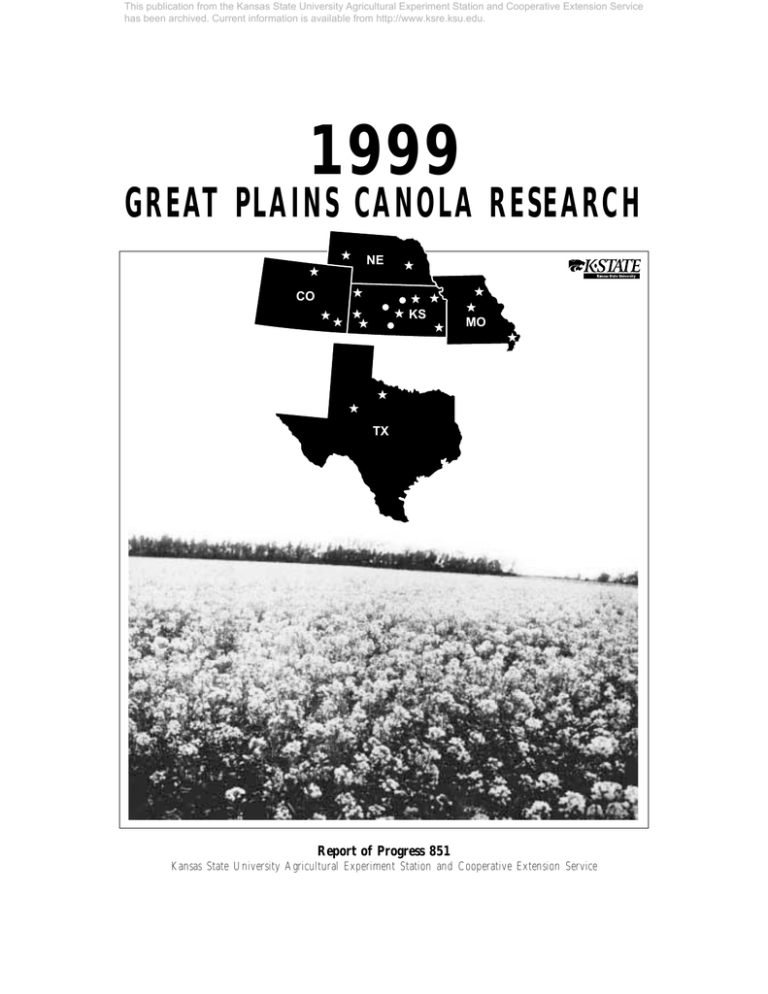
This publication from the Kansas State University Agricultural Experiment Station and Cooperative Extension Service
has been archived. Current information is available from http://www.ksre.ksu.edu.
1999
GREAT PLAINS CANOLA RESEARCH
NE
CO
KS
MO
AR
TX
Report of Progress 851
Kansas State University Agricultural Experiment Station and Cooperative Extension Service
This publication from the Kansas State University Agricultural Experiment Station and Cooperative Extension Service
has been archived. Current information is available from http://www.ksre.ksu.edu.
CONTENTS
INTRODUCTION . . . . . . . . . . . . . . . . . . . . . . . . . . . . . . . . . . . . . . . . . . . . . . . . . . . . . . . . . . . . . . . . . . . . . . . . . .
1
1999 GREAT PLAINS CANOLA VARIETY TESTS. . . . . . . . . . . . . . . . . . . . . . . . . . . . . . . . . . . . . . . . . . . . . . . .
2
Objectives . . . . . . . . . . . . . . . . . . . . . . . . . . . . . . . . . . . . . . . . . . . . . . . . . . . . . . . . . . . . . . . . . . . . . . . . . . . . .
2
Procedures . . . . . . . . . . . . . . . . . . . . . . . . . . . . . . . . . . . . . . . . . . . . . . . . . . . . . . . . . . . . . . . . . . . . . . . . . . . .
3
Growing Condition . . . . . . . . . . . . . . . . . . . . . . . . . . . . . . . . . . . . . . . . . . . . . . . . . . . . . . . . . . . . . . . . . . . . . .
3
Test Locations.. . . . . . . . . . . . . . . . . . . . . . . . . . . . . . . . . . . . . . . . . . . . . . . . . . . . . . . . . . . . . . . . . . . . . . . .
3
ACKNOWLEDGMENTS . . . . . . . . . . . . . . . . . . . . . . . . . . . . . . . . . . . . . . . . . . . . . . . . . . . . . . . . . . . . . . . . . . . .
3
RESULTS FROM GREAT PLAINS LOCATIONS OF THE 1999 NATIONAL WINTER CANOLA VARIETY TRIAL
Colby, KS, Table 1
.....................................................................
4
Garden City, KS, Table 2
................................................................
6
Hutchinson, KS, Table 3
.. . . . . . . . . . . . . . . . . . . . . . . . . . . . . . . . . . . . . . . . . . . . . . . . . . . . . . . . . . . . . . .
8
.................................................................
10
Ottawa, KS, Table 5 . . . . . . . . . . . . . . . . . . . . . . . . . . . . . . . . . . . . . . . . . . . . . . . . . . . . . . . . . . . . . . . . . . . .
12
Parsons, KS, Table 6 . . . . . . . . . . . . . . . . . . . . . . . . . . . . . . . . . . . . . . . . . . . . . . . . . . . . . . . . . . . . . . . . . . .
14
Columbia, MO, Table 7 . . . . . . . . . . . . . . . . . . . . . . . . . . . . . . . . . . . . . . . . . . . . . . . . . . . . . . . . . . . . . . . . . . .
16
Novelty, MO, Table 6
18
Manhattan, KS, Table 4
...................................................................
.................................................................
20
Lincoln, NE, Table 10 . . . . . . . . . . . . . . . . . . . . . . . . . . . . . . . . . . . . . . . . . . . . . . . . . . . . . . . . . . . . . . . . . . . .
22
Sidney, NE, Table 11 . . . . . . . . . . . . . . . . . . . . . . . . . . . . . . . . . . . . . . . . . . . . . . . . . . . . . . . . . . . . . . . . . . . .
24
Bushland, TX, Table 12. . . . . . . . . . . . . . . . . . . . . . . . . . . . . . . . . . . . . . . . . . . . . . . . . . . . . . . . . . . . . . . . . . . .
26
Munday, TX, Table 13 . . . . . . . . . . . . . . . . . . . . . . . . . . . . . . . . . . . . . . . . . . . . . . . . . . . . . . . . . . . . . . . . . . .
28
Figure 1. Great Plains Winter Canola Summary, 1996-1999. . . . . . . . . . . . . . . . . . . . . . . . . . . . . . . . . . . . . .
30
Table 14. Sources of Seed for Great Plains Entries in the 1999 National Winter Canola Variety Trial . . . . .
32
Portageville, MO, Table 9
Contribution no. 00-311-S from the Kansas Agricultural Experiment Station.
This publication from the Kansas State University Agricultural Experiment Station and Cooperative Extension Service
has been archived. Current information is available from http://www.ksre.ksu.edu.
1999 Great Plains Canola Research
INTRODUCTION
FDA in the United States ruled that rapeseed
oil with less than 2 percent erucic acid is
safe for human consumption. One year
later, the American Heart Association urged
Americans to reduce their saturated fat
intake.
Canola oil contains 6 percent
saturated fat, the lowest level of any
commercially available vegetable oil.
Canola oil consumption increased
from zero prior to 1986 to the equivalent of
over 2 million acres of production in 1994.
This represented an increase in consumption
of 50% since 1992. Most of this oil was
imported from Canada. Canola is one of the
few new crops that possessed a substantial
market before its production was
established. United States canola production
has tripled in the past 3 years and reached
1.13 million acres in 1998, but consumption
still outpaces production at the rate of nearly
3 to 1. Most of this production is from
spring types in the northern Great Plains
states of North Dakota, Montana, and
Minnesota. Over the past few years, interest
in winter cultivars also has increased in
areas where production is feasible,
especially the Pacific Northwest, Southern
Great Plains, and the Southeast. A crushing
facility at Velva, ND has been crushing
canola for several years. Colorado Mills,
Lamar, CO, began crushing canola and other
oilseeds in 1999 and was the delivery point
for the 1999 southern Great Plains crop.
Several oilseed crushers in the Great Plains
are capable of crushing canola and will
crush the crop when sufficient quantities
become available.
Canola-quality seed has been
developed in three Brassica species
Canola is a specific crop developed
from rapeseed. Canola also has been called
double zero rapeseed because of the low
contents of erucic acid (less than 2 percent
in the oil) and glucosinolates (less than 30
micromoles per gram in the oil-free meal).
Food and oil-processing industries have a
great interest in canola, because it produces
a high-quality oil that is lower in saturated
fat than other sources of dietary fats. The
meal remaining after oil extraction is used as
a protein supplement by the livestock
industry.
Production of rapeseed was first
reported in Europe in the 13th century, but it
probably has been cultivated in Asia for
thousands of years. It always has been used
in Asia for cooking oil, but it was used
originally in Europe as a source of lamp oil
and lubricant. During World War II, Canada
grew millions of acres to provide a marine
lubricant, but production declined as diesel
replaced steam engines.
The first oilseed rape with low levels
of erucic acid in the oil was developed in
Canada in 1957.
Interest in rapeseed
increased, and Canadian production reached
1 million acres in 1965. In 1971, ‘Span’, the
first low erucic acid variety, was released.
Three years later, ‘Tower’ was released. It is
low in both erucic acid and glucosinolates
and became the first true canola variety.
The term canola was trademarked by the
Western Canadian Oilseed Crushers
Association in 1978 and still is used to
describe rapeseed that is genetically low in
erucic acid and glucosinolates. In 1985, the
1
This publication from the Kansas State University Agricultural Experiment Station and Cooperative Extension Service
has been archived. Current information is available from http://www.ksre.ksu.edu.
Brassica napus, also called Argentine rape,
market interest by oil processors.
Canola production would fit well
into Great Plains agriculture. Canola makes
an excellent rotational crop with winter
wheat. Yields of wheat following canola are
reported to be 8 to 12% better than yields of
wheat following wheat. Because canola is a
broadleaf crop, more effective and less
expensive herbicides can be used to control
grass weeds. No major diseases are common
between the two crops, so canola can help
break some disease cycles. Canola also is
produced with the same equipment used for
small grains.
A major investment in
equipment is not needed to try a small
canola acreage. Because canola is an
oilseed, its commodity price is not tied to
that of grains, and it can be used to help
spread economic risk to more than one
commodity class
summer rape, winter rape, or Swede rape,
was the first and is the most common canola
grown. Brassica rapa, also called B.
campestris, Polish rape, summer turnip rape,
or field mustard, has many canola-quality
cultivars and is grown on a large acreage
where it is adapted Brassica juncea (yellow
mustard) lines with canola quality have been
identified. Cultivars are just now being
released, and all B. juncea lines are spring
types. Most winter canola varieties grown in
the United States have been developed from
B. napus.
Winter canola yields are generally
30% greater than yields of the spring types.
Winter canola is planted in late summer.
The plants need to reach the 6 to 8 true-leaf
stage and about 8 to 10 inches in height
before freeze-down to increase winter
survival. Plants overwinter as rosettes and
bolt early the next spring. Harvest takes
place about the same time as winter wheat
harvest in a given area.
Canola research began in the United
States in the late 1980’s. Industrial rapeseed
had been investigated prior to this, but
because of the limited demand for this
product, interest was low. Winter canola
production was attempted in the late 1980’s
but was not successful. The failure was
primarily due to the lack of adapted
varieties, t h e l a c k o f m a n a g e m e n t
recommendations for the area, and the lack
of a local market for the crop. Since that
time, canola-quality lines have been
developed that are significant improvements
varieties.
previously
tested
over
Advancements in production research have
led to management recommendations
consistent with the conditions of the region.
Increased oil consumption has led to
increased demand for canola seed and a
1999 GREAT PLAINS CANOLA
VARIETY TESTS
Objectives
The data reported here are from the
Great’ Plains locations of the National
Winter Canola Variety Trial. The objectives
of these tests are to evaluate germplasm over
a wide range of environments, determine
what canola varieties and experimental lines
are adapted to what areas, and to increase
the visibility of winter canola across the
regions. Information obtained from these
tests will help determine what experimental
lines should be released and where released
cultivars might be marketed. Over the past
few years, this trial has expanded the
number of environments and now has
locations in the Great Plains, Midwest, and
diversity in
wide
Southeast.
The
environments has increased our knowledge
and understanding of rapeseed germplasm
2
This publication from the Kansas State University Agricultural Experiment Station and Cooperative Extension Service
has been archived. Current information is available from http://www.ksre.ksu.edu.
for use in the Great Plains.
precipitation, and the thin line represents the
actual precipitation over the growing season.
Procedures
This test was distributed to 16
locations in the Great Plains during the fall
of 1998. It included 14 released varieties and
17 experimental lines from six different
breeding programs. Management guidelines
were supplied to each cooperator, but past
experience at that locality was used for final
management decisions. Local management,
site descriptions, and growing conditions
can be found on the page for each location
established. All tests were planted in small
plots (approximately 100 square feet) and
replicated three times. The University of
Idaho, Moscow, ID, performed analysis for
total oil samples. Results for yield and
winter survival at most locations also
include data from previous years or 2-year
and 3-year summaries. Lines are listed in
order from highest to lowest yields for 1999.
Test Locations
Of the 16 tests distributed in 1998,
all but two were established successfully (Ft.
Collins, and Walsh, CO). Only two locations
did not survive the winter (Manhattan, KS
and Lincoln, NE). Five other sites were lost
during the spring growing season (Parsons,
Garden City, and Ottawa, KS; Sidney, NE;
and Lubbock, TX), leaving yield data from
seven locations in three states.
This test was continued in 19992000 and included 19 experimental lines
from five different breeding programs and
16 released cultivars. Three production
centers also were established in Kansas in
1999-2000. These sites are located on
farmers’ fields and include fertility, seeding
rate, and variety studies. Production
management information will be included in
future publications.
1998-99 Growing Conditions
For most locations, temperature and
precipitation data are plotted at the bottom
of the site description page.
On the
temperature graph, the thick black line
represents the long-term average daily
temperatures (ºF) for that location. The
upper thin line represents the actual daily
high temperatures, and the lower thin line
represents the actual daily low temperatures
over the 1998-99 growing season. On the
precipitation graph, the thick black line
represents
the
long-term
average
ACKNOWLEDGMENTS
This work was funded in part by the
National Canola Research Program, United
States Department of Agriculture,
Cooperative States Research Program and
the Kansas Agricultural Experiment Station.
Assistant Scientist Cindy LaBarge, as well
as student workers Gaylon Corley, Maria
Sweat, and Barrett Robinson helped with
planting, care, harvest, and data preparation
of some of these tests.
3
This publication from the Kansas State University Agricultural Experiment Station and Cooperative Extension Service
has been archived. Current information is available from http://www.ksre.ksu.edu.
This publication from the Kansas State University Agricultural Experiment Station and Cooperative Extension Service
has been archived. Current information is available from http://www.ksre.ksu.edu.
This publication from the Kansas State University Agricultural Experiment Station and Cooperative Extension Service
has been archived. Current information is available from http://www.ksre.ksu.edu.
This publication from the Kansas State University Agricultural Experiment Station and Cooperative Extension Service
has been archived. Current information is available from http://www.ksre.ksu.edu.
This publication from the Kansas State University Agricultural Experiment Station and Cooperative Extension Service
has been archived. Current information is available from http://www.ksre.ksu.edu.
This publication from the Kansas State University Agricultural Experiment Station and Cooperative Extension Service
has been archived. Current information is available from http://www.ksre.ksu.edu.
This publication from the Kansas State University Agricultural Experiment Station and Cooperative Extension Service
has been archived. Current information is available from http://www.ksre.ksu.edu.
This publication from the Kansas State University Agricultural Experiment Station and Cooperative Extension Service
has been archived. Current information is available from http://www.ksre.ksu.edu.
This publication from the Kansas State University Agricultural Experiment Station and Cooperative Extension Service
has been archived. Current information is available from http://www.ksre.ksu.edu.
This publication from the Kansas State University Agricultural Experiment Station and Cooperative Extension Service
has been archived. Current information is available from http://www.ksre.ksu.edu.
This publication from the Kansas State University Agricultural Experiment Station and Cooperative Extension Service
has been archived. Current information is available from http://www.ksre.ksu.edu.
This publication from the Kansas State University Agricultural Experiment Station and Cooperative Extension Service
has been archived. Current information is available from http://www.ksre.ksu.edu.
Table 6. Results from the 1999 National Canola Variety Trial at Parsons, KS.
____________________________________________________________________________________________________________________________________________________________________
Yield
Line
1999
1997
Winter Survival
2yr 1/
1999
2yr2 /
3yr3 /
Fall
50%
Stand
Bloom4 /
____________________________________________________________________________________________________________________________________________________________________
------------------- lb/ac ------------------ARC91003-7L-3
------------------- % -------------------
%
date
ARC91004-12L-3
-------
-------
-------
67
75
83
88
-------
27
20
4/22
4/21 e
ARC91022-59L-4
----
----
----
100
100
----
17
4/22
ARC91016-41L-2
----
----
----
50
----
----
20
4/24
ARC91017-44E-5
----
----
----
83
----
----
30
4/21 e
IDWR.465.2.4.8
----
----
----
85
93
----
47
4/21 e
ID92WC2.24.5.3
----
----
----
93
97
----
60 *
4/21 e
ID92WC2.14.1.2
----
----
----
89
----
----
37
4/24 l
ID93WC.4.6.3
----
----
----
89
----
----
57 *
4/21 e
ID93WC.5.17.3
----
----
----
93
----
----
53 *
4/23
KS3203
----
892
----
100
100
100
33
4/21 e
Wichita
----
694
871
96
98
97
33
4/22
MO503-1
----
687
881
83
92
94
37
4/22
GA488.7H
KS1701
-------
---310
---746
67
50
83
75
---83
37
33
4/22
4/24
WW1089
----
----
----
100
100
----
20
4/26 l
Bridger
----
614
710
100
100
100
50 *
4/21 e
Casino
----
817
----
95
98
98
50 *
4/21 e
Ceres
----
1166
973
100
100
100
40
4/22
Contact
----
----
----
64
----
----
47
4/25 l
DC H29
----
----
----
69
----
----
47
4/21 e
Ericka
----
373
----
94
97
98
57 *
4/20 e
Falcon
-------
1387 *
1730 *
-------
100
100
100
100
100
98
63 *
60 *
4/21 e
4/20 e
Jetton
Olsen
Pendleton
----
----
----
83
----
----
47
4/22
Plainsman
----
1352 *
1200 *
95
98
98
40
4/25 l
Selkirk
ST994
-------
757
1035
-------
95
90
98
----
98
----
47
60 *
4/22
4/23
Winfield
----
1041
829
100
100
100
37
4/22
Mean
----
712
776
87
93
95
42
4/22
LSD (0.05)
-------
524
43.6
213
36.3
NS
26
NS
----
NS
----
16
23
1.792
4.92
CV (%)
____________________________________________________________________________________________________________________________________________________________________
*
1/
2/
3/
Upper LSD group - Differences among those marked with an asterisk are not statistically significant.
2yr means include data from 1995 and 1997.
2yr means include data from 1998 and 1999.
3yr means include data from 1997, 1998, and 1999.
4/ Values marked "e" are not statistically different from the earliest value; and those marked "l" are not different from the latest value.
15
This publication from the Kansas State University Agricultural Experiment Station and Cooperative Extension Service
has been archived. Current information is available from http://www.ksre.ksu.edu.
This publication from the Kansas State University Agricultural Experiment Station and Cooperative Extension Service
has been archived. Current information is available from http://www.ksre.ksu.edu.
Table 9. Results from the 1999 National Canola Variety Trial, Columbia, MO.
____________________________________________________________________________________________________________________________________________________________________
Yield
Line
1999
Winter Survival
Fall
Plant
Mois-
Total
2yr
1/
3yr 2/
1999
3yr 2/
Stand
Height 3/ Lodging
ture
____________________________________________________________________________________________________________________________________________________________________
------------ lb/ac ------------
-------- % --------
%
in.
%
Oil
%
%
42.8 *
Ceres
2450 *
1992 *
1972 *
100
100
78 *
48 s
8 *
13.4
KS3203
2071 *
1725 *
1974 *
100
100
10
55 t
8 *
14.9
40.7
Ericka
1999 *
1355
1577 *
100
100
37
48 s
0 *
15.1
40.5
Falcon
1660 *
1471
1733 *
100
100
37
57 t
17 *
14.4
42.5 *
Jetton
1644 *
1620 *
1861 *
100
100
22
44 s
0 *
13.0
42.1
Pendleton
1608 *
-----
-----
100
----
35
52
0 *
13.6
42.5 *
ID92WC2.14.1.2
1504
-----
-----
100
----
33
51
0 *
13.9
42.2 *
Olsen
1445
-----
-----
100
----
79 *
46 s
8 *
14.1
42.9 *
Bridger
1409
1209
1405
100
100
28
52
0 *
13.6
43.9 *
ID93WC.5.17.3
1356
-----
-----
100
----
49
61 t
8 *
17.4
40.7
ID92WC2.24.5.3
1236
1457
-----
100
----
50
55 t
0 *
14.1
41.5
ID93WC.4.6.3
1220
-----
-----
100
----
31
52
0 *
14.0
43.1 *
Casino
1202
1362
1965 *
100
100
23
58 t
8 *
13.3
40.9
DC H29
1154
-----
-----
100
----
24
54
8 *
13.8
42.0
IDWR.465.2.4.8
1042
982
-----
100
----
30
55 t
0 *
13.3
43.1 *
Selkirk
1023
1034
1358
100
100
25
56 t
0 *
13.0
42.7 *
Contact
932
-----
-----
100
----
19
49 s
0 *
12.9
43.6 *
Wichita
764
1178
1621 *
100
100
13
47 s
13.1
40.9
25
ARC91017-44E-5
754
-----
-----
100
----
30
49 s
15.3
42.5 *
GA488.7H
618
1033
-----
100
----
17
48 s
33
8 *
14.3
41.3
MO503-1
599
893
1202
100
100
16
48 s
17 *
11.6
40.9
Plainsman
599
1177
1494
100
100
14
56 t
25
13.8
39.5
Winfield
565
817
1286
100
100
12
50 s
8 *
13.8
43.0 *
ST994
536
-----
-----
100
----
25
50 s
8 *
12.6
43.9 *
ARC91016-41L-2
406
-----
-----
100
----
9
49 s
8 *
11.6
41.6
ARC91022-59L-4
399
748
-----
100
----
11
50 s
17 *
11.2
39.7
KS1701
351
562
1066
100
100
9
49 s
8 *
13.4
41.8
WW1089
324
897
-----
100
----
10
47 s
17 *
11.9
41.6
ARC91003-7L-3
306
1000
-----
100
----
3
46 s
25
10.2
41.7
ARC91004-12L-3
261
808
-----
100
----
7
49 s
33
12.7
39.1
41.8
1048
1150
1421
100
100
26
51
10
13.4
LSD (0.05)
Mean
933
519
443
NS
NS
17
7
21
NS
1.8
CV (%)
54.5
36.5
33.2
----
----
39.9
8.1
129.4
14.4
2.6
____________________________________________________________________________________________________________________________________________________________________
*
1/
2/
3/
Upper LSD group - Differences among those marked with an asterisk are not statistically significant.
2yr means include data from 1998 and 1999.
3yr means include data from 1997, 1998, and 1999.
Values marked "s" are not statistically different from the shortest value; those marked "t" are not statistically different from the tallest.
17
This publication from the Kansas State University Agricultural Experiment Station and Cooperative Extension Service
has been archived. Current information is available from http://www.ksre.ksu.edu.
This publication from the Kansas State University Agricultural Experiment Station and Cooperative Extension Service
has been archived. Current information is available from http://www.ksre.ksu.edu.
Table 10. Results from the 1999 National Canola Variety Trial, Novelty, MO.
________________________________________________________________________________________________________________________________________________________________
Yield
Line
1999
Winter Survival
Plant
Mois-
Total
2yr
1/
1999
2yr 1/
Height
Lodging
ture
Oil
________________________________________________________________________________________________________________________________________________________________
-------- lb/ac --------
-------- % --------
in.
%
%
%
Olsen
2028 *
-----
100
----
49
17
12.7
Casino
1885 *
1582
100
100
44
25
13.8
40.3
Jetton
1878 *
1752 *
100
100
44
17
12.3
40.7
Wichita
1841 *
1810 *
100
100
47
8
14.6
40.5
Pendleton
1795 *
100
----
48
8
12.7
40.9
-----
41.0
Falcon
1742 *
1706 *
100
100
52
8
12.2
40.3
Selkirk
1642 *
1404
100
100
49
8
14.6
41.0
1922 *
100
100
48
8
11.8
40.8
100
----
46
17
14.9
43.7 *
100
100
49
33
17.4
39.2
ID92WC2.24.5.3
1621 *
ST994
1587 *
WW1089
1522
1969 *
-----
MO503-1
1517
1407
100
100
46
25
11.9
40.0
ID93WC.4.6.3
1514
-----
100
----
49
17
12.4
41.7 *
Plainsman
1488
1662 *
100
100
47
25
13.4
38.3
ARC91004-12L-3
1478
1803 *
100
100
47
33
11.7
36.7
ID92WC2.14.1.2
1478
-----
100
----
53
25
10.9
40.9
Ceres
1448
1602
100
100
42
25
14.9
40.1
ID93WC.5.17.3
1424
-----
100
----
44
8
14.5
39.7
Contact
1419
-----
100
----
45
17
11.0
42.4 *
GA488.7H
1367
1522
100
100
51
17
13.0
39.5
IDWR.465.2.4.8
1310
1242
100
100
45
33
12.6
41.1
39.7
ARC91016-41L-2
1302
-----
100
----
46
25
13.3
ARC91022-59L-4
1261
1309
100
100
46
25
12.3
40.0
ARC91017-44E-5
1247
-----
100
----
45
8
13.0
40.7
KS1701
1224
1035
100
100
43
38
15.9
40.2
Bridger
1212
1241
100
100
47
33
12.0
40.7
KS3203
1202
1527
100
100
48
0
14.1
39.0
DC H29
1150
-----
100
----
42
42
11.8
39.8
Ericka
38.9
1112
1120
100
100
44
25
12.0
ARC91003-7L-3
987
1345
100
100
45
17
13.0
39.3
Winfield
838
983
100
100
45
33
12.5
40.2
Mean
40.2
1451
1450
100
100
47
21
13.1
LSD (0.05)
461
344
NS
NS
NS
NS
NS
2.1
CV (%)
19.5
20.9
----
----
9.6
95.1
20.7
3.2
________________________________________________________________________________________________________________________________________________________________
* Upper LSD group - Differences among those marked with an asterisk are not statistically significant.
1/ 2yr means include data from 1998 and 1999.
19
This publication from the Kansas State University Agricultural Experiment Station and Cooperative Extension Service
has been archived. Current information is available from http://www.ksre.ksu.edu.
This publication from the Kansas State University Agricultural Experiment Station and Cooperative Extension Service
has been archived. Current information is available from http://www.ksre.ksu.edu.
Table 11. Results from the 1999 National Canola Variety Trial, Portageville, MO.
________________________________________________________________________________________________________________________________________________________________
Yield
Line
1999
Winter Survival
Fall
Plant
Total
2yr
1/
1999
2yr 1/
Stand
Height 2/
Lodging
Oil
________________________________________________________________________________________________________________________________________________________________
-------- lb/ac --------
--------- % ---------
%
in.
%
%
Casino
2335 *
1874 *
100
84 *
42
45 t
10 *
38.8
Falcon
2186 *
1684 *
100
78 *
77 *
40 st
20 *
40.0 *
ID93WC.4.6.3
2079 *
-----
100
----
33
41 t
20 *
38.7
ID92WC2.14.1.2
1941 *
-----
100
----
77 *
43 t
13 *
39.4 *
IDWR.465.2.4.8
1914 *
-----
100
----
42
45 t
20 *
40.2 *
GA488.7H
1712 *
-----
100
----
23
43 t
30
39.0
ID93WC.5.17.3
1642 *
-----
100
----
63 *
44 t
13 *
36.1
Pendleton
1629 *
-----
100
----
32
40 st
13 *
39.4 *
Bridger
1571 *
1223
100
70 *
53 *
42 t
27
40.9 *
Jetton
1415 *
1404 *
100
73 *
47
33 s
20 *
40.2 *
ID92WC2.24.5.3
1278
-----
100
----
63 *
40 t
13 *
39.5 *
ARC91016-41L-2
1192
-----
100
----
5
38 s
17 *
38.2
DC H29
1039
-----
100
----
28
40 st
20 *
36.0
Ceres
1003
1147
100
74 *
40
34 s
13 *
38.9
929
987
100
81 *
23
44 t
13 *
40.7 *
38.1
KS3203
Plainsman
914
908
100
72 *
15
43 t
13 *
Olsen
911
-----
100
----
77 *
39 st
10 *
38.6
Ericka
908
781
100
65
55 *
36 s
10 *
39.6 *
Winfield
731
667
100
66
40
39 st
33
36.4
ARC91017-44E-5
697
-----
100
----
5
35 s
33
39.4 *
ARC91022-59L-4
697
-----
100
----
5
37 s
23
39.7 *
ARC91003-7L-3
663
-----
100
----
8
38 s
27
39.8 *
38.1
MO503-1
599
684
100
75 *
27
37 s
20 *
Contact
489
-----
100
----
32
35 s
20 *
41.9 *
Wichita
474
645
100
65
10
37 s
13 *
38.6
Selkirk
440
445
100
61
52 *
39 st
17 *
37.4
ARC91004-12L-3
388
-----
100
----
8
36 s
23
40.7 *
ST994
303
900
100
77 *
13
39 st
23
39.4 *
WW1089
281
-----
100
----
15
36 s
13 *
39.0
UGA96200E
248
439
100
57
37
33 s
13 *
39.8 *
100
Mean
1087
966
68
35
39
19
38.8
LSD (0.05)
944
480
NS
15
28
7
11
2.7
CV (%)
42.5
39.9
----
26.5
50.0
10.6
36.9
4.3
________________________________________________________________________________________________________________________________________________________________
* Upper LSD group - Differences among those marked with an asterisk are not statistically significant.
1/ 2yr means include data from 1997 and 1999.
2/ Values marked "s" are not statistically different from the shortest value; and those marked "t" are not different from the tallest value.
21
This publication from the Kansas State University Agricultural Experiment Station and Cooperative Extension Service
has been archived. Current information is available from http://www.ksre.ksu.edu.
This publication from the Kansas State University Agricultural Experiment Station and Cooperative Extension Service
has been archived. Current information is available from http://www.ksre.ksu.edu.
This publication from the Kansas State University Agricultural Experiment Station and Cooperative Extension Service
has been archived. Current information is available from http://www.ksre.ksu.edu.
24
This publication from the Kansas State University Agricultural Experiment Station and Cooperative Extension Service
has been archived. Current information is available from http://www.ksre.ksu.edu.
This publication from the Kansas State University Agricultural Experiment Station and Cooperative Extension Service
has been archived. Current information is available from http://www.ksre.ksu.edu.
This publication from the Kansas State University Agricultural Experiment Station and Cooperative Extension Service
has been archived. Current information is available from http://www.ksre.ksu.edu.
This publication from the Kansas State University Agricultural Experiment Station and Cooperative Extension Service
has been archived. Current information is available from http://www.ksre.ksu.edu.
This publication from the Kansas State University Agricultural Experiment Station and Cooperative Extension Service
has been archived. Current information is available from http://www.ksre.ksu.edu.
This publication from the Kansas State University Agricultural Experiment Station and Cooperative Extension Service
has been archived. Current information is available from http://www.ksre.ksu.edu.
This publication from the Kansas State University Agricultural Experiment Station and Cooperative Extension Service
has been archived. Current information is available from http://www.ksre.ksu.edu.
This publication from the Kansas State University Agricultural Experiment Station and Cooperative Extension Service
has been archived. Current information is available from http://www.ksre.ksu.edu.
Table 14. Sources of Seed for Great Plains Entries in the 1999 National Winter
Canola Variety Trial.
Seed Source
Entries
Calgene Oil Division
1190-A U.S. Route 19 South
Leesburg, GA 31763
Falcon
Jetton
ST994
Cargill Seeds
P.O. Box 5645
Minneapolis, MN 55440
Contact
DC H29
Kansas State University
Department of Agronomy
Throckmorton Hall
Manhattan, KS 66506-5501
KS1701
KS3203
Wichita (KS3580)
Plainsman
Winfield
McKay Seed Company
2945 Road N N.E.
Moses Lake, WA 98837
Ceres
Pendleton
Olsen
Spectrum Crop Devlopment
Post Office Box 541
Ritzville, WA 99169
WW1089
Casino
University of Arkansas
Department of Plant Science
Fayetteville, AR 72701
ARC91003-7L-3
ARC91004-12L-3
ARC91016-41L-2
ARC91017-44E-5
ARC91022-59L-4
University of Georgia
Department of Crop & Soil Science
Georgia Station, Griffin, GA 30223-1797
UGA488.7H
UGA96200E
University of Idaho
Dept. of Plant, Soil, and Envir. Science
Moscow, ID 83843-4196
Bridger
Ericka
ID92WC2.14.1.2
ID.92.WC.2.24.5
ID93WC.4.6.3
ID93WC.5.17.3
ID.WR.465.2.4
Selkirk
University of Missouri
Waters Hall
Columbia, MO 65211
M0503-1
32
This publication from the Kansas State University Agricultural Experiment Station and Cooperative Extension Service
has been archived. Current information is available from http://www.ksre.ksu.edu.
Publications from K-State Research and Extension are available on the World Wide Web at
http://www.oznet.ksu.edu
Contents of this publication may be freely reproduced for educational purposes. All other rights reserved.
In each case, give credit to the author(s), name the work, Kansas State University, and the date the work was
published.
Trade names are used to identify products. No endorsement is intended, nor is any criticism implied of similar
products not named.
This publication from the Kansas State University Agricultural Experiment Station and Cooperative Extension Service
has been archived. Current information is available from http://www.ksre.ksu.edu.
Senior Author
Charles Rife, Dept. of Agronomy, Kansas State Univ., Manhattan
Other Contributors
William Heer, KSU South Central Experiment Field, Hutchinson
Keith Janssen, KSU East Central Experiment Field, Ottawa
James Long, KSU Southeast Agricultural Research Center, Parsons
Herbert Sunderman, KSU Northwest Research-Extension Center, Colby
Merle Witt, KSU Southwest Research-Extension Center, Garden City
Richard Auld, Texas Tech University, Lubbock
David Baltensperger, University of Nebraska, Scottsbluff
Brent Bean, Texas A&M University, Bushland
David Bordovsky, Texas A&M University, Vernon
Duane Johnson, Colorado State University, Ft. Collins
Harry Minor, University of Missouri, Columbia
Lenis Nelson, University of Nebraska, Lincoln
Kansas State University Agricultural Experiment Station and Cooperative Extension Service, Manhattan 66506
SRP 851
March 2000
It is the policy of Kansas State University Agricultural Experiment Station and Cooperative Extension Service that all persons shall have equal opportunity and
access to its educational programs, services, activities, and materials without regard to race, color, religion, national origin, sex, age, or disability. Kansas State
University is an equal opportunity organization. These materials may be available in alternative formats.
1M

